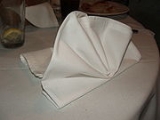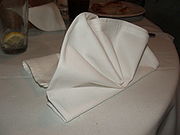
Napkin
Encyclopedia

Middle English
Middle English is the stage in the history of the English language during the High and Late Middle Ages, or roughly during the four centuries between the late 11th and the late 15th century....
, borrowing the French
French language
French is a Romance language spoken as a first language in France, the Romandy region in Switzerland, Wallonia and Brussels in Belgium, Monaco, the regions of Quebec and Acadia in Canada, and by various communities elsewhere. Second-language speakers of French are distributed throughout many parts...
nappe—a cloth covering for a table—and adding -kin, the diminutive suffix.
In the United Kingdom and Canada both terms, serviette and napkin, are used. In the UK, napkins are traditionally U
U and non-U English
U and non-U English usage, with U standing for upper class, and non-U representing the aspiring middle classes, were part of the terminology of popular discourse of social dialects in 1950s Britain and New England. The debate did not concern itself with the speech of the working classes, which in...
and serviette non-U. In some places, serviettes are those made of paper whereas napkins are made of cloth. The word serviette in lieu of the term napkin is not typically used in American English
American English
American English is a set of dialects of the English language used mostly in the United States. Approximately two-thirds of the world's native speakers of English live in the United States....
, though, as discussed is not uncommon in Canadian English and Canadian French. In Australia, 'serviette' generally refers to the paper variety and 'napkin' refers to the cloth variety.
Conventionally, the napkin is often folded and placed to the left of the place setting, outside the outermost fork
Fork
As a piece of cutlery or kitchenware, a fork is a tool consisting of a handle with several narrow tines on one end. The fork, as an eating utensil, has been a feature primarily of the West, whereas in East Asia chopsticks have been more prevalent...
. In an ambitious restaurant setting or a caterer
Catering
Catering is the business of providing foodservice at a remote site or a site such as a hotel, public house , or other location.-Mobile catering:A mobile caterer serves food directly from a vehicle or cart that is designed for the purpose...
's hall, it may be folded into more or less elaborate shapes and displayed on the empty plate. A napkin may also be held together in a bundle (with cutlery) by a napkin ring
Napkin ring
The napkin ring, sometimes called serviette ring, was originally used to identify the napkins of a household between weekly wash days. The standard napkin ring is a simple ring made from skewers. The figural napkin ring is an American specialty in which the simple napkin ring is part of a small...
. Alternatively, paper napkins may be contained with a napkin holder
Napkin holder
A napkin holder is a device used to hold napkins. A napkin holder can be made from virtually any solid material and is built so that the napkins do not slip from its hold, either by way of sandwiching them between two surfaces, or simply enclosing them on their sides in a horizontal design...
.
Napkins were used in ancient Roman times. One of the earliest references to table napkins in English dates to 1384–85.
Summaries of napkin history often say that the ancient Greeks used bread to wipe their hands. This is suggested by a passage in one of Alciphron
Alciphron
Alciphron was an ancient Greek sophist, and the most eminent among the Greek epistolographers. Regarding his life or the age in which he lived we possess no direct information whatsoever.-Works:...
's letters (3:44), and some remarks by the sausage seller in Aristophanes
Aristophanes
Aristophanes , son of Philippus, of the deme Cydathenaus, was a comic playwright of ancient Athens. Eleven of his forty plays survive virtually complete...
' play, The Knights
The Knights
The Knights was the fourth play written by Aristophanes, the master of an ancient form of drama known as Old Comedy. The play is a satire on the social and political life of classical Athens during the Peloponnesian War and in this respect it is typical of all the dramatist's early plays...
. The bread in both texts is referred to as apomagdalia, which simply means bread from inside the crust known as the crumb, and not special "napkin bread".
See also
- paper napkins
- sanitary napkinSanitary napkinA sanitary napkin, sanitary towel, sanitary pad, menstrual pad, maxi pad, or pad is an absorbent item worn by a woman while she is menstruating, recovering from vaginal surgery, for lochia , abortion, or any other situation where it is necessary to absorb a flow of blood from a woman's vagina.These...
- wet wipeWet wipeA wet wipe, also known as a wet nap, wet towel, or a moist towelette, is a small moistened piece of paper or cloth that often comes folded and individually wrapped for convenience...

